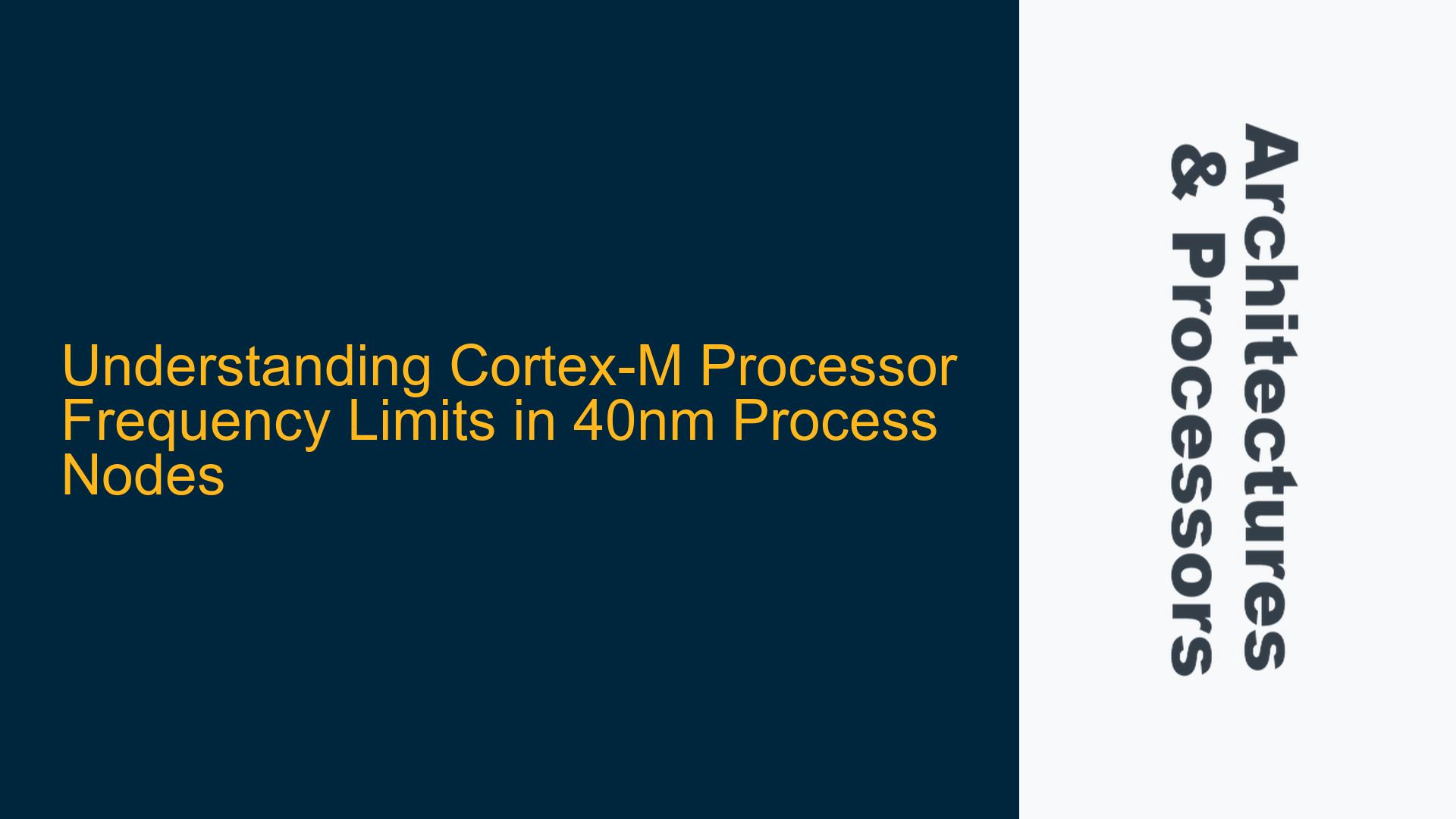Cortex-M Processor Frequency Ranges and Architectural Constraints
The maximum operating frequency of ARM Cortex-M processors is a critical parameter that directly impacts the performance and power consumption of embedded systems. Cortex-M processors, such as the Cortex-M4 and Cortex-M7, are widely used in microcontroller units (MCUs) across various industries. The frequency at which these processors operate is influenced by several factors, including the manufacturing process node, pipeline depth, and architectural design choices. For instance, the Cortex-M7, with its 6-stage pipeline, is designed to achieve higher clock frequencies compared to the Cortex-M4, which typically features a 3-stage pipeline. In a 40nm process node, the Cortex-M7 can achieve frequencies up to 600MHz, as demonstrated by NXP’s iMX RT series. On the other hand, Cortex-M4-based MCUs, such as those in the STM32 series, often operate at frequencies up to 240MHz. These differences in frequency capabilities are not arbitrary but are rooted in the architectural and process-level optimizations of each processor.
The manufacturing process node plays a significant role in determining the maximum achievable frequency. A 40nm process node offers a balance between performance, power efficiency, and cost, making it a popular choice for many Cortex-M-based MCUs. However, the actual frequency achieved in a specific implementation depends on additional factors such as the quality of the silicon, the design of the clock distribution network, and the thermal characteristics of the device. For example, NXP’s iMX RT1050, built on a 40nm process, achieves 600MHz by leveraging the Cortex-M7’s deeper pipeline and optimized instruction execution. In contrast, STMicroelectronics’ STM32F4 series, which uses the Cortex-M4, operates at lower frequencies due to its simpler pipeline and different design priorities.
Understanding the relationship between pipeline depth and frequency is essential for selecting the right processor for a given application. A deeper pipeline, like that of the Cortex-M7, allows for higher clock speeds by breaking down instruction execution into more stages, reducing the critical path delay in each stage. However, this comes at the cost of increased latency for branch instructions and potential pipeline stalls. The Cortex-M4, with its shorter pipeline, sacrifices some frequency headroom for lower latency and simpler design, making it more suitable for applications where deterministic timing is critical.
Impact of Process Node and Pipeline Depth on Cortex-M Frequency
The frequency capabilities of Cortex-M processors are heavily influenced by the interplay between the manufacturing process node and the architectural design of the processor. In a 40nm process node, the physical characteristics of the transistors and interconnects set a baseline for the maximum achievable frequency. However, the actual frequency is also determined by the processor’s microarchitecture, particularly the depth of the instruction pipeline. The Cortex-M7’s 6-stage pipeline is a key factor in its ability to reach 600MHz in a 40nm process. Each pipeline stage handles a smaller portion of the instruction execution, allowing the clock period to be shorter and the frequency to be higher. This design choice is particularly effective in applications where raw processing power is prioritized over low-latency response times.
In contrast, the Cortex-M4’s 3-stage pipeline is optimized for simplicity and low-latency operation. While this limits its maximum frequency to around 240MHz in a 40nm process, it provides benefits in applications where real-time responsiveness is critical. For example, in motor control or sensor interfacing, the Cortex-M4’s shorter pipeline ensures that interrupts are handled with minimal delay, making it a better fit for such use cases. The trade-off between pipeline depth and frequency is a fundamental aspect of processor design, and understanding this trade-off is crucial for selecting the right Cortex-M processor for a given application.
Another factor that affects the maximum frequency is the quality of the silicon and the design of the clock distribution network. Variations in the manufacturing process can lead to differences in transistor performance, which in turn affect the maximum stable frequency. Additionally, the clock distribution network must be carefully designed to minimize skew and ensure that the clock signal reaches all parts of the processor simultaneously. Any imperfections in the clock distribution can limit the maximum frequency or lead to timing violations, causing the processor to malfunction.
Thermal considerations also play a role in determining the maximum frequency. As the clock frequency increases, so does the power consumption, leading to higher temperatures. If the heat generated cannot be effectively dissipated, the processor may throttle its frequency to prevent overheating. This is particularly relevant in embedded systems, where thermal management solutions are often limited by size and cost constraints. Therefore, the maximum frequency specified for a Cortex-M processor is not just a function of its architecture and process node but also of the thermal design of the system in which it is deployed.
Optimizing Cortex-M Processor Frequency for Specific Applications
To maximize the performance of Cortex-M processors in a 40nm process node, it is essential to consider both the architectural characteristics of the processor and the specific requirements of the application. For applications that demand high computational throughput, such as digital signal processing or complex control algorithms, the Cortex-M7’s 600MHz capability makes it an attractive choice. However, achieving this frequency requires careful attention to the design of the clock distribution network, the quality of the silicon, and the thermal management of the system. Designers must also consider the impact of the deeper pipeline on interrupt latency and branch prediction, as these factors can affect the real-time performance of the system.
For applications where low-latency response is more critical than raw processing power, the Cortex-M4’s 240MHz frequency may be more appropriate. The shorter pipeline of the Cortex-M4 ensures that interrupts are handled quickly, making it well-suited for real-time control tasks. Additionally, the lower power consumption of the Cortex-M4 at its maximum frequency can be advantageous in battery-powered or thermally constrained applications. Designers should also consider the availability of peripherals and development tools when selecting a Cortex-M processor, as these factors can significantly impact the ease of development and the overall system performance.
In some cases, it may be necessary to trade off frequency for power efficiency or cost. For example, a lower clock frequency can reduce power consumption and extend battery life in portable devices. Alternatively, selecting a processor with a lower maximum frequency but a more robust set of peripherals may simplify the design and reduce the overall system cost. The key is to carefully analyze the requirements of the application and select a Cortex-M processor that provides the best balance of performance, power efficiency, and cost.
Finally, it is important to consider the long-term availability and scalability of the chosen processor. As technology advances, newer process nodes may become available, offering higher frequencies and lower power consumption. Selecting a processor that is part of a scalable family, such as the Cortex-M series, ensures that the design can be easily migrated to newer process nodes in the future. This not only extends the lifespan of the product but also provides opportunities for performance improvements and cost reductions over time.
In conclusion, the maximum frequency of Cortex-M processors in a 40nm process node is determined by a combination of architectural design, process node characteristics, and system-level considerations. By understanding these factors and carefully analyzing the requirements of the application, designers can select the right Cortex-M processor and optimize its performance to meet the needs of their specific use case. Whether prioritizing high computational throughput, low-latency response, or power efficiency, the Cortex-M series offers a range of options to suit a wide variety of embedded applications.






